
click on the flag to reach the translation

Une Earthcache
Il ne s’agit pas d’une cache physique. Pour loguer cette cache, vous devez dans un premier temps prendre connaissance de sa description éducative en matière de géologie, puis d’observer le site sur lequel vous êtes, et enfin de répondre aux questions qui vous seront posées.
Vous pourrez alors loguer en "Found it" sans attendre mais vous devez me faire parvenir vos réponses en même temps en me contactant soit par mail dans mon profil, soit via la messagerie geocaching.com (Message Center), et je vous contacterai en cas de problème. Les logs enregistrés sans réponses seront supprimés.

Un peu de géologie
Un matériau inaltérable ?
A l’échelle des temps géologiques, le granite peut se dégrader très rapidement d’autant plus que la vitesse de désagrégation du granit dépend du climat. L’altération du granite début généralement le long de fissures dans lesquelles l’eau pénètre. Dans un climat tempéré, elle conduit à la formation de boules de granite puis d’un chaos granitique avec la formation d’une arène granitique formée principalement de granis de quartz, mais aussi de micas altérés, de feldspaths pouvant évoluer jusqu’au stade d’argile kaolinique.
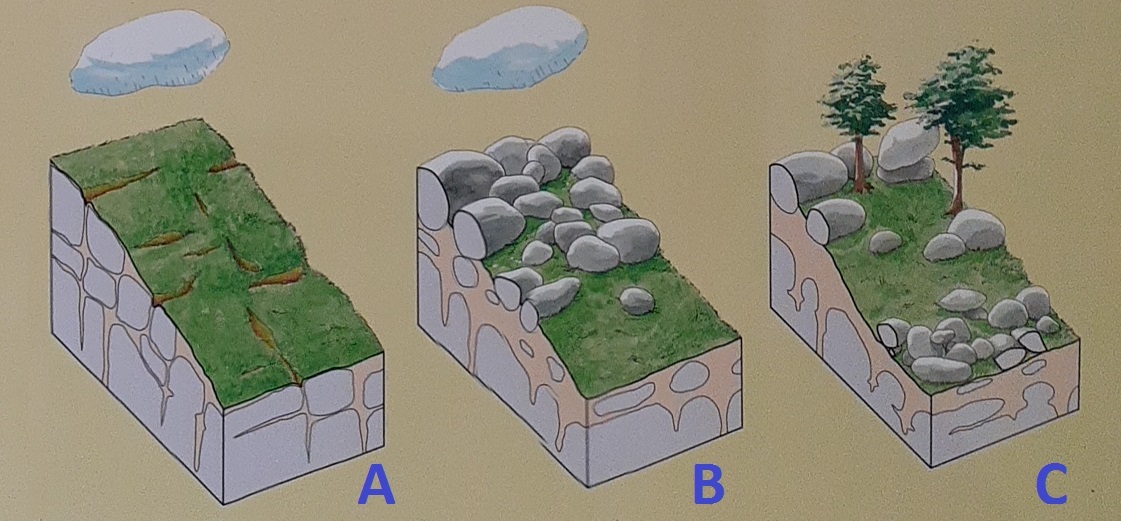 A) Granite sain fracturé recouvert d’un sol, infiltration d’eau de pluie dans les fractures du granite
A) Granite sain fracturé recouvert d’un sol, infiltration d’eau de pluie dans les fractures du granite
B) Altération par l’eau du granite en arène granitique le long des fractures
C) Erosion et transport de l’arène par le ruissellement des eaux de pluie, les boules de granite restent sur place : formation d’un chaos granitique
Causes de l'altération surfacique naturelle
Une série d’altérations communes affectent principalement la surface du granite: les desquamations en plaque, les desquamations superficielles, les croûtes salines, les fissures et fractures, les parties manquantes et des altérations chromatiques ponctuelles.
Les principales causes d’altération sont: la nature des minéraux constitutifs ayant des coefficients d’expansion thermique différents; les variations importantes de température et d’humidité; l’effet de l’eau et des sels qui y sont dissouts.
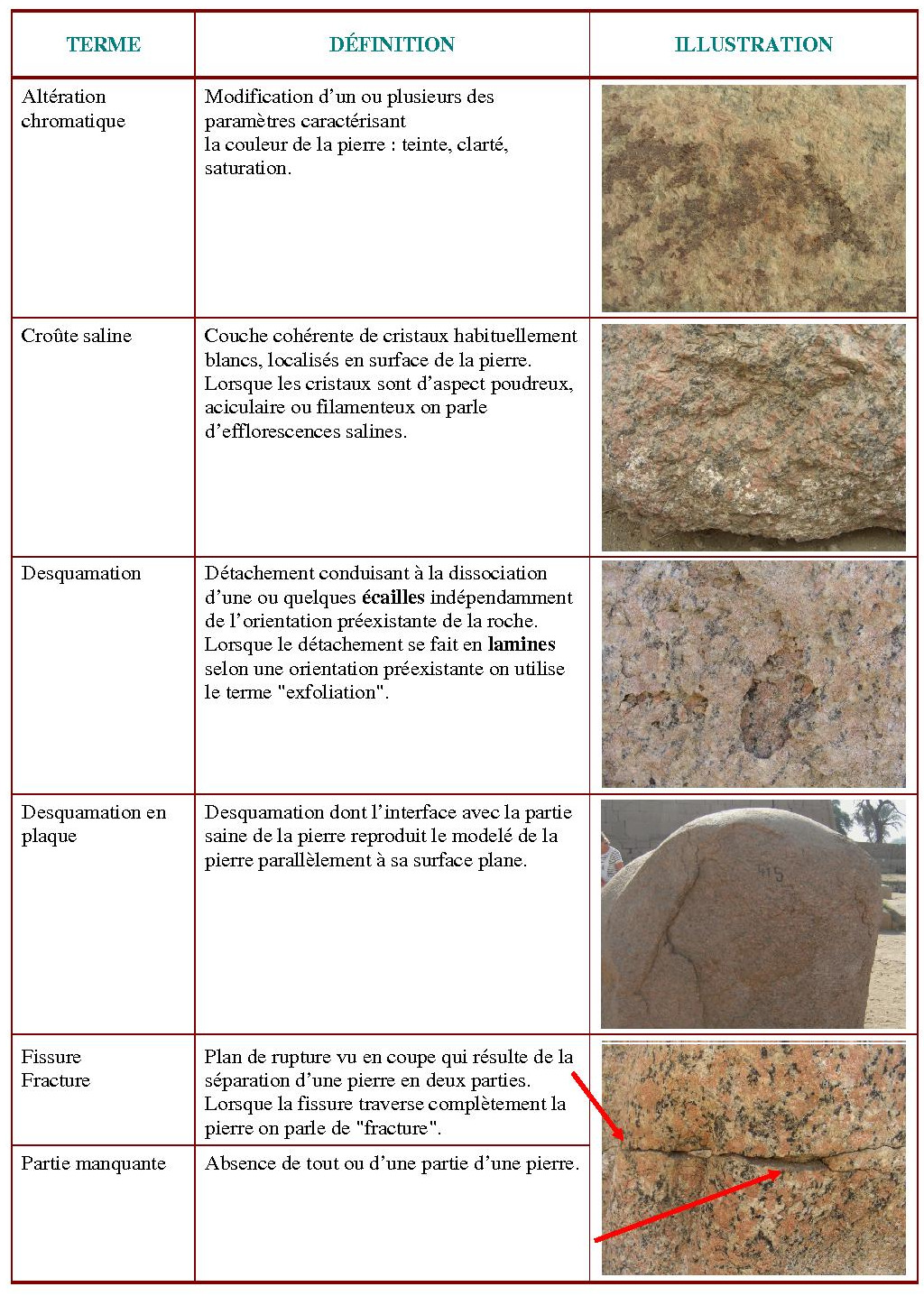
Altérations destructives de la pierre de construction
Une première agression apparaît ainsi au cours de l'histoire géologique des roches.Un second traumatisme apparait à partir de l'extraction de la roche par l'homme en tant de pierre de contruction.
L'extraction de la roche de son milieu d'origine la soumet à une décompression générale, à un changement d'humidité, de température d'équilibre chimique. Le matériau "pierre" connait alors une modification de sa structure, parfois impossible à déceler à l'oeil nu, qui la fragilise. Ensuite, le façonnage de la pierre multiplie sa surface de contact avec les agents extérieurs, contact qui contribue à l'accélération de son évolution.
La mise en œuvre de la pierre dans l'édifice la soumet à de nouvelles contraintes et expositions. Les blocs subissent des pressions mécaniques nouvelles et les agents d'érosion atmosphérique: la pluie, le vent, les alternances de température, le gel, les polutions chimiques, les micro-organismes... La pierre en œuvre connait donc à son interface avec son environnement de nombreuses réactions physico-chimiques qui altèrent son aspect, sa surface puis sa structure même, ce qui a terme met en danger l'ensemble de l'édifice qu'elle compose. L'altération des matériaux et la destruction progressive des ouvrages son inéluctable.
On distingue 5 grandes catégories de formes d’altération de la roche en tant que pierre de construction dont certaines étaient déjà présentes à la première altération géologique :
- Fissures et déformation (fracture, clivage…)
- Détachement (boursoufflure, éclatement, délitage, désagrégation, fragmentation, pelage, desquamation)
- Figures induites par des pertes de matière (alvéolisation, érosion, dégât mécanique, microkarst, partie manquante, perforation, pitting)
- Altération chromatique et dépôt (croûte, dépôt, altération chromatique, efflorescence, encroûtement, aspect luisant, graffiti, patine, encrassement, subefflorescence)
- Colonisation biologique (colonisation biologique, algue, lichen, mousse, moisissure, plante)
La présence d'eau est déterminante dans l’apparition de la plupart des altérations. L'eau mobilise les sels solubles, gèle, dissout les minéraux, favorise l’implantation et l'activité des organismes vivants, modifie les propriétés mécaniques...
- Lessivage et dissolution: L’effet combiné de la dissolution chimique et de l’action érosive provoquée par le lessivage des eaux de pluies émousse les reliefs et fait disparaitre les formes
- Encroutement et colonisation par les végétaux: Les zones humides abritées sont propices à la colonisation par les végétaux (mousses, lichens). Des particules atmosphériques peuvent aussi s’agglomérer et conduire à la formation d’une croûte noire.
Questions
Question 0 - Prenez une photo de vous, ou de votre objet distinctif de géocacheur, ou de votre pseudo écrit sur une feuille de papier ou dans votre main... devant l'autel de l'église, et joignez-là à votre log ou à vos réponses
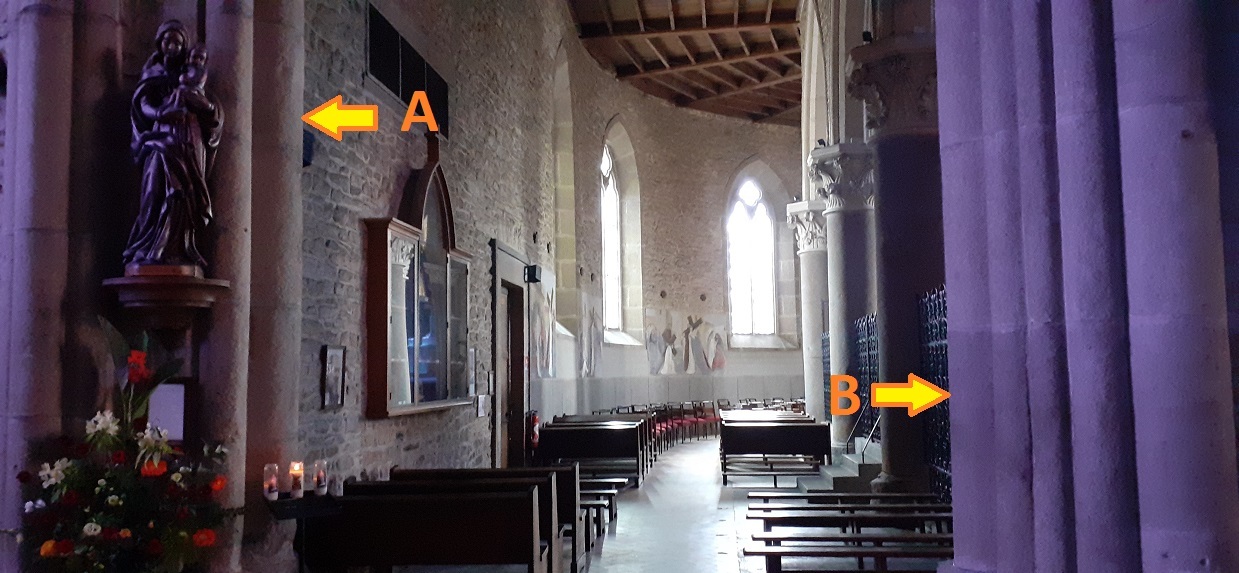
Zone d'observation A - Observez le haut de la colonne A.
Question 1 - Décrivez l'altération que vous voyez ?
Question 2 - Nommez l'altération (cf leçon) ?
Question 3 - A quoi est-elle due selon vous ?
Zone d'observation B - Observez l'arrière de la colonne B à hauteur d'homme.
Question 4 - Décrivez ce que vous voyez à l'endroit où "ça brille"?
Question 5 - Nommez l'altération (cf leçon) ?
Question 6 - A quoi est-elle due selon vous (plusieurs causes sont possibles, pensez à la hauteur à laquelle vous l'observez?
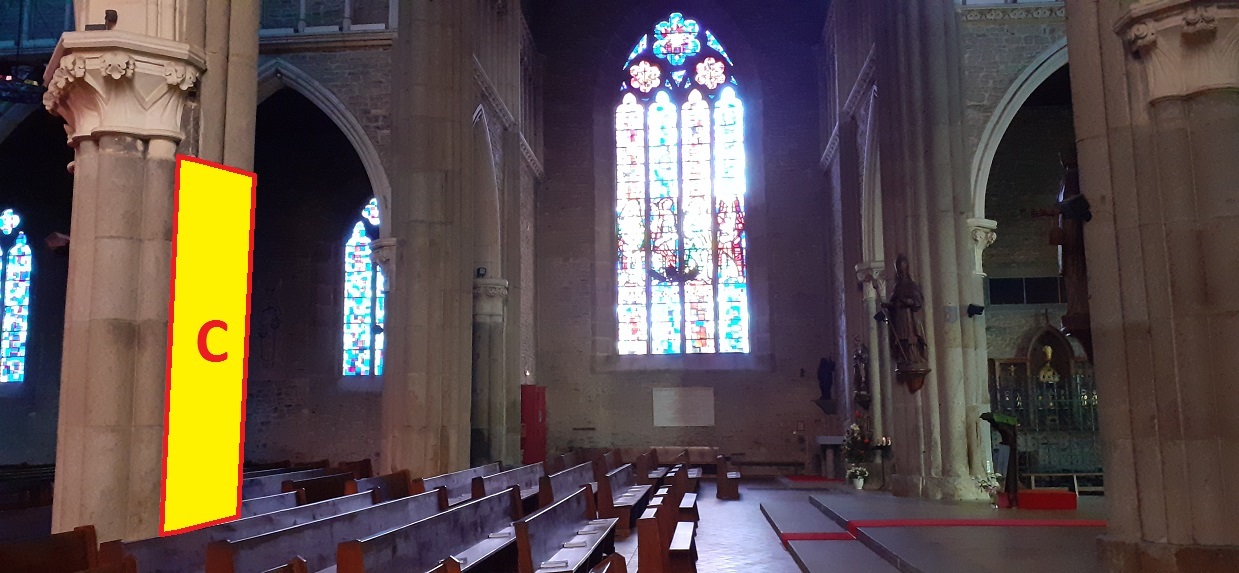
Zone d'observation C - Observez la partie haute indiquée de la colonne C.
Question 7 - Décrivez l'altération principale que vous voyez ?
Question 8 - Nommez l'altération (cf leçon) ?
Question 9 - Observez, toujours en hauteur, le piédestal accolé, et également le mur (dos à vous selon l'axe de la photo)de l'autre côté de l'allée de passage. Quelle nouvelle forme d'altération pouvez-vous constater ?
Question 10 - Nommez l'altération (cf leçon) ?
Question 11 - A quoi est-elle due selon vous ?
Question 12 - L'histoire récente de l'église vient renseigner ce qui a pu se passer à cet endroit et qui serait venu renforcer ces altérations importantes ici: quel serait ce facteur agravant ?
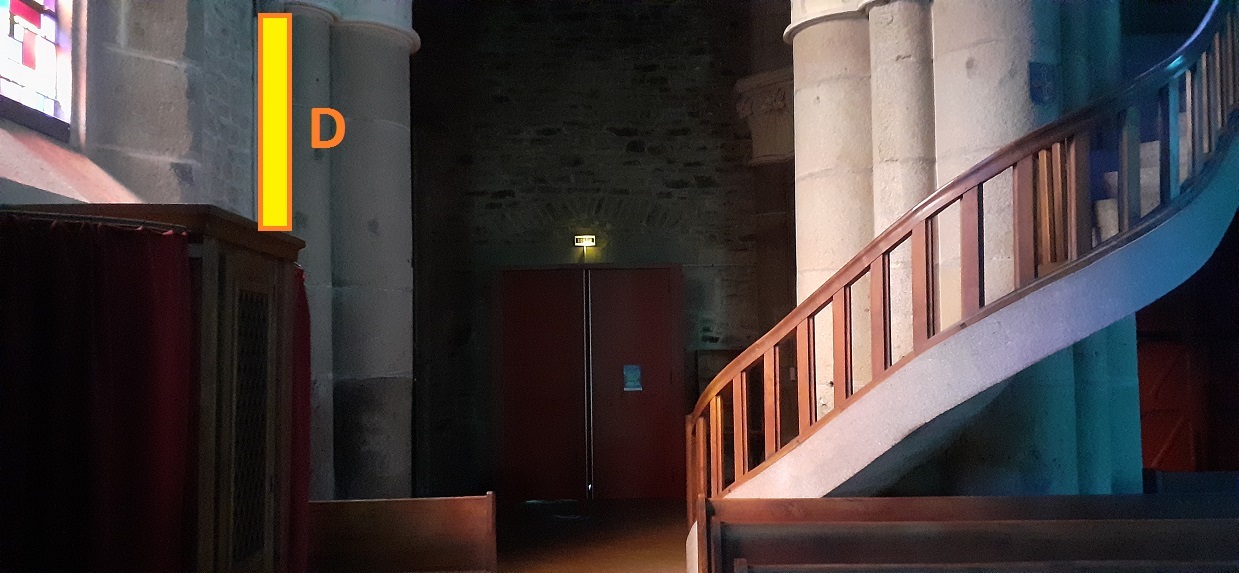
Zone d'observation D - Observez la partie haute, proche du câble électrique, indiquée au niveau de la colonne D.
Question 13 - Qu'est-il en train de se passer, altération et conséquence ?
Question 14 - Reprenons les altérations observées en A, C, D... Que risque-t-il de se passer au niveau de l'église dans un certain temps ?


An Earthcache
It is not a physical cache. To log this cache, you must first learn about its educational description in geology, then observe the site on which you are, and finally answer the questions that will be asked.
You can then log in "Found it" without waiting but you must send me your answers at the same time by contacting me either by mail in my profile, or via the messaging geocaching.com (Message Center), and I will contact you in case of problem. Saved logs without answers will be deleted.

A little of geology
An unalterable material?
On the geological time scale, granite can degrade very quickly, especially since the rate at which granite disintegrates depends on the climate. Weathering of granite usually begins along cracks where water enters. In a temperate climate, it leads to the formation of granite balls then a granitic chaos with the formation of a granitic arena formed mainly of quartz granis, but also of altered micas, feldspars that can evolve to the stage of kaolin clay.
 A) Sound fractured granite covered with soil, infiltration of rainwater into the granite fractures
A) Sound fractured granite covered with soil, infiltration of rainwater into the granite fractures
B) Water alteration of granite in granite arena along the fractures
C) Erosion and transport of the arena by the runoff of rainwater, the granite balls remain in place: formation of a granite chaos
Causes of surface alteration
A series of common alterations mainly affect the surface of granite: plaque desquamation, superficial desquamation, salt crusts, cracks and fractures, missing parts and occasional chromatic alterations.
The main causes of deterioration are: the nature of the constituent minerals having different thermal expansion coefficients; significant variations in temperature and humidity; the effect of water and the salts dissolved in it.

Destructive alterations of building stone
A first aggression thus appears in the course of the geological history of rocks. A second trauma appears from the extraction of the rock by man as building stone.
The extraction of the rock from its environment of origin subjects it to a general decompression, to a change of humidity, of chemical equilibrium temperature. The material "stone" then undergoes a modification of its structure, sometimes impossible to detect with the naked eye, which weakens it. Then, the shaping of the stone multiplies its surface of contact with the external agents, contact which contributes to the acceleration of its evolution.
The use of stone in the building subjects it to new constraints and exposures. The blocks undergo new mechanical pressures and atmospheric erosion agents: rain, wind, temperature changes, frost, chemical pollution, microorganisms ... The stone in work therefore knows at its interface with its environment of numerous physicochemical reactions which alter its appearance, its surface and its very structure, which ultimately endangers the entire structure it makes up. The deterioration of materials and the gradual destruction of structures are inevitable.
There are 5 main categories of weathering forms of rock as a building stone, some of which were already present at the first geological weathering:
- Cracks and deformation (fracture, cleavage ...)
- Detachment (blistering, bursting, crumbling, disintegration, fragmentation, peeling, desquamation)
- Figures induced by material losses (alveolisation, erosion, mechanical damage, microkarst, missing part, perforation, pitting)
- Chromatic alteration and deposit (crust, deposit, chromatic alteration, efflorescence, crusting, shiny appearance, graffiti, patina, fouling, subefflorescence)
- Biological colonization (biological colonization, algae, lichen, moss, mold, plant)
The presence of water is a determining factor in the appearance of most deteriorations. Water mobilizes soluble salts, freezes, dissolves minerals, promotes implantation and activity of living organisms, modifies mechanical properties ...
- Leaching and dissolution : The combined effect of chemical dissolution and erosive action caused by the leaching of rainwater dulls the reliefs and makes the shapes disappear
- Encrustation and colonization by plants : Sheltered wetlands are conducive to colonization by plants (mosses, lichens). Airborne particles can also clump together and lead to the formation of a black crust.
Questions
Question 0 - Take a photo of yourself, or your geocacher feature, or your written nickname on a sheet of paper or in your hand ... in front of the church altar, and attach it to your log or your answers

Observation area A - Observe the top of column A.
Question 1 - Describe the alteration you see?
Question 2 - Name the alteration (see lesson)?
Question 3 - What do you think is due?
Observation area B - Observe the rear of column B at breast height.
Question 4 - Describe what you see where "it shines"?
Question 5 - Name the alteration (see lesson)?
Question 6 - What do you think it is due to (several causes are possible, think about how high you are?)

Observation area C - Observe the upper part indicated in column C.
Question 7 - Describe the main alteration you see?
Question 8 - Name the alteration (see lesson)?
Question 9 - Observe, still in height, the attached pedestal, and also the wall (back to you along the axis from the photo) across the aisle. What new form of weathering can you see?
Question 10 - Name the alteration (see lesson)?
Question 11 - What do you think is due?
Question 12 - The recent history of the church provides information on what may have happened there and what would be come to reinforce these important alterations here: what would be this aggravating factor?

Observation area D - Observe the upper part, close to the electric cable, indicated in column D.
Question 13 - What is happening, alteration and consequence?
Question 14 - Let's go back to the alterations observed in A, C, D ... What is likely to happen at church level in a while?